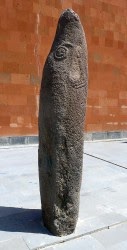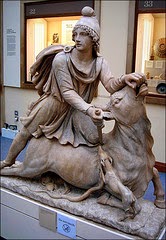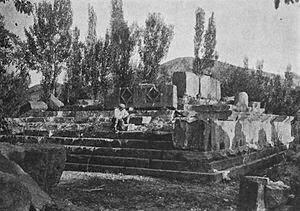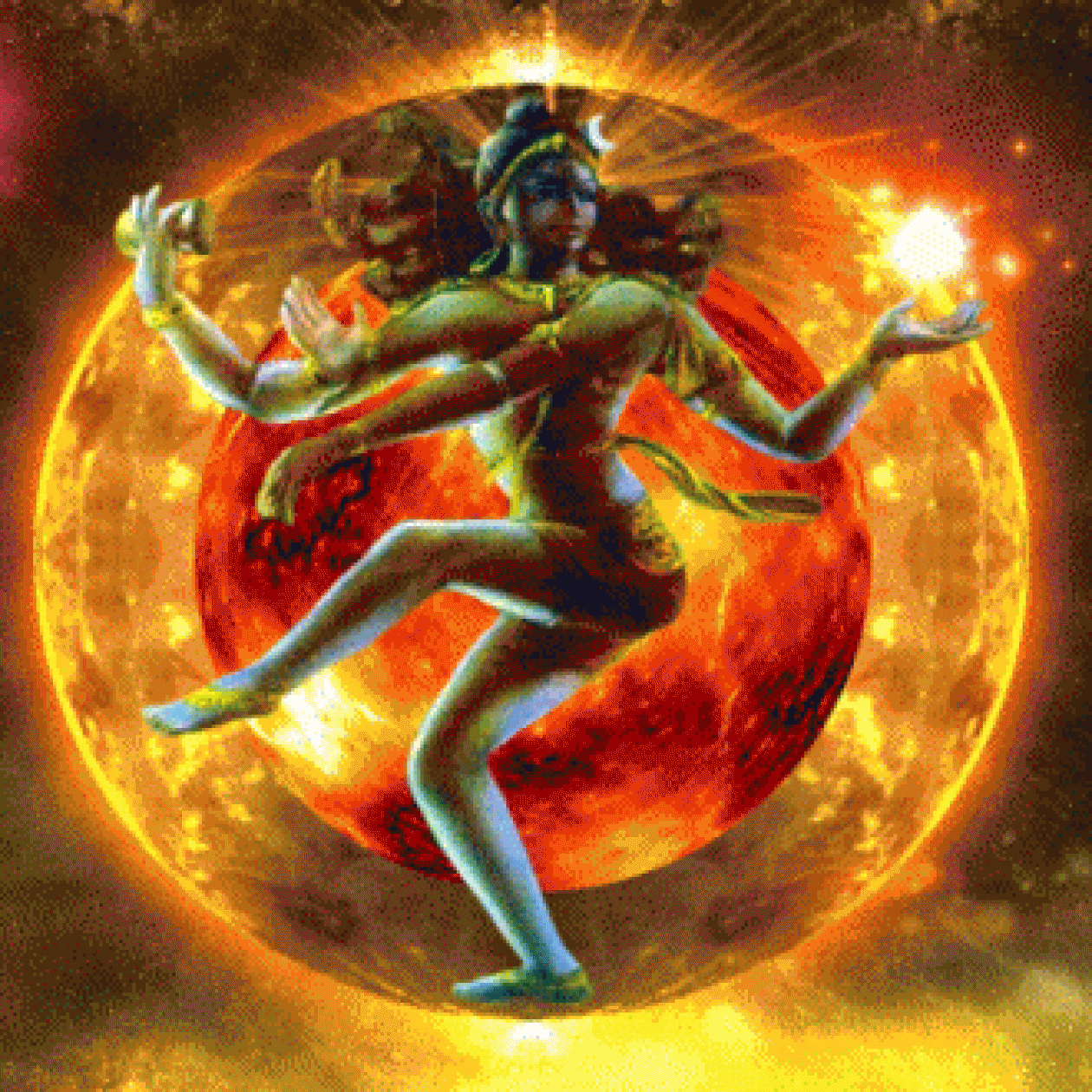THE TEMPLE OF GARNI IN ARMENIA – THE VEDIC-SANSKRIT CONNECTION
The oldest surviving building in Armenia is the Temple of Garni represented by Mithira, the Sun God. Mithira is said to have been adapted into the Zoroastrian pantheon from the Rig Vedic deity ‘Mitra’ who is ‘an important divinity of Indic culture, and the patron divinity of honesty, friendship, contracts and meetings’. Also the word ‘mitra’ (मित्र) often translated as ‘friend’ from Sanskrit, also means ‘sun’.

A Uratian ‘Vishapa’ is connected with water
much like the Vedic Shivalinga. The Uratian pagan
tradition was gradually rejected by the Zoroastrians.
‘Mitra’ evolved into its Zoroastrian form of ‘Mithira’ during the Bronze and Iron Ages, and was later carried to Greece by remnants of Alexander the Great’s armies in the 3rd-2nd century BC, where it was incorporated into the Greek concept of the ‘Helios’- the Sun god. Again ‘heli’ (हेलि) means ‘sun’ in Sanskrit.
The Temple of Garni was built in the 2nd century BC over the site of an even more ancient Uratian temple dated to 3rd century BC. Uratian culture is associated with the mysterious phallic stones found all over Armenia and known as the ‘Vishapa’. The Vishapa stones are connected with water much like the Vedic Shivalinga.
The closest Sanskrit cognate to the word ‘Vishapa’ is ‘Vrishabha’ (वृषभ) which means ‘bull’ and is sacred to the Hindus. ‘Nandi’ the ‘bull’ is the vehicle of Lord Shiva. Near the Temple of Garni an artifact of a hoof of a bull, modeled with white marble, was discovered, which once belonged to a pagan idol at the temple premises destroyed during the adoption of Christianity. The rise of Christianity demolished both Paganism and later Zoroastrianism in Armenia.
Adds Vinay Vaidya, ” ‘Vishapa’ is ‘Vrishabha’ (वृषभ) which means ‘bull’. Near the Temple of Garni a hoof of a bull artifact was found. In Sanskrit, ‘shapha’ (शफ) means ‘hoof’, ‘vishapha’ means ‘of a big hoof’, that becomes ‘Bishop’ in Chess….”.

Mithira slaying the Bull or ‘Vrishbha’.
As Zoroastrianism grew, its Vedic
antecedents were rejected.
Hence, the slaying of Shiva’s bull ‘Nandi’. |
In the 1st century AD the Temple of Garni was ruined by Roman armies. In 79 AD Garni was reconstructed by Tridat I, who called it the ‘inaccessible temple’ in his Greek inscription. Tridat, apart from being the Armenian King was also a Zoroastrian priest. His name bears the same meaning in Avestan, the language of the Zoroastrians as it does in Sanskrit. The Sanskrit ‘Tridata’ (त्रिदाता) is the Vedic trinity of ‘Bramha, Vishnu and Mahesh’. ‘Tri’ (त्रि) is ‘three’ and ‘dAtA’ (दाता) means ‘giver’ – and his name meant the Zoroastrian equivalent of ‘given by Trinity’.
Vinay Vaidya sheds light on the name Garni. He says, “Garni could be seen as derived directly from ‘GhRNi’ (घृणि) meaning the ‘Sun’, ‘Mitra’ (as mentioned above) is another evidence. ‘Om GhRNi sUryAya namaH’ is the Vedika mantra for worshiping the Sun. ‘GhUrNa’ (घूर्ण) means to revolve, rotate. And this too is about those planets including the Sun and the Moon, which revolve on the celestial circular orbit.” The Garni temple collapsed in the 1679 earth-quake and was reconstructed between 1969 and 1974.
Garni Temple was made of basalt, probably transported from the nearby Geghard monastery which itself was partially carved out of a monolithic basalt mountain – much like the cave temples of India. The Geghard monastery is built over the site of a sacred spring arising inside a cave. This too indicates a Vedic and Hindu link. Springs are sacred in India and there are many many ancient temples built around spring areas. Caves too are held sacred and have been the seat of ascetics since antiquity.
 The ruined Temple of Garni during early
The ruined Temple of Garni during early
20th century before it was reconstructed.
The Rig Veda says that all the inhabitants of the earth emerged from the primordial sea and water is regarded as sacred. It says, “The waters that are from the firmament and flow after being dug, and even those that spring by themselves, the bright pure waters which lead to the sea, may those divine waters protect me here.”

Geghard Monastery, 10 km away from
Temple of Garni was carved out of a basalt mountain
built on the site of a spring inside a cave
sacred to ancient Armenians. |
The Garni structure can be seen as a representation of the cosmos, with nine steps leading to a raised platform representing the ‘navagraha’ (नवग्रह) or ‘nine planets’ of Vedic cosmology which include the Sun and Moon; Mars, Mercury, Venus, Jupiter and Saturn; and the two nodes – Rahu and Ketu. The temple has 24 basalt columns representing the 24 hours of the day.

The reconstructed sun Temple of Garni. The temple as it stands today was reconstructed between 1969 to1974.

The carving on the frieze of the Garni temple does not appear on its 24 columns indicating that the base belongs to a different time and school of architecture.
Closeness and links to ancient India and Armenia are visible in its many artifacts. Here’s one that most of us will immediately recognize. This artifact, titled was found at The Church of St. Paul and St. Peter in Tomarza in central Turkey which was built as late as 1570 – over a far more ancient site.

Artifact from Church of St. Paul and St. Peter of Tomarza dated to 1570, in Turkey (a part of the ancient Armenian Civilization) is titled as the ‘hand of God’ it is evident that this is a ‘Yogic Hand Mudra’,

The ‘Prithvi Mudra’ in Indian Sculpture

Yogic ‘Hand Mudras’.


 The ruined Temple of Garni during early
The ruined Temple of Garni during early













Reblogged this on GLOBAL HINDUISM.
LikeLike
In the Brahmanical i.e. Non Puranic, Vedic tradition, Brahma is not part of a trinity. From Brahma comes his light Mitra who together with his fluid Varuna and matter Aryama form the cosmos. Mitra forms and sustains 12,000 types of Suns. From the Sun comes his light Savitur (father) comprising the three Gunas of Virinchi (creative etc), Narayana (sustaining etc) and Shankara (transcreative etc), who, as light, warmth etc (Sandhya), life etc (Savitri), sound etc (Gayatri) and knowledge etc (Sarasvathi) forms and sustains life here in unison with water (Aapa) and soil (Bhu) the two mothers:
LikeLike
Excellent sir. With your permission , could I add this in blog with excerpts with your name?
LikeLike
Reblogged this on Voices and Visions.
LikeLike
Pingback: THE TEMPLE OF GARNI IN ARMENIA – THE VEDIC-SANSKRIT CONNECTION | HINDUISM AND SANATAN DHARMA – GLOBAL HINDUISM
Pingback: THE TEMPLE OF GARNI IN ARMENIA – THE VEDIC-SANSKRIT CONNECTION | HINDUISM AND SANATAN DHARMA – Voice of world